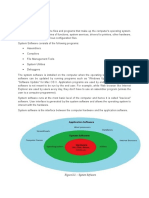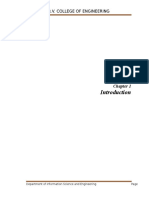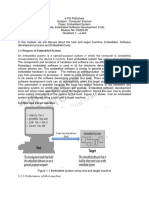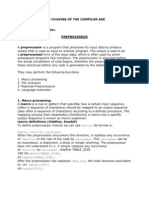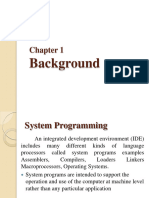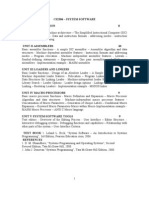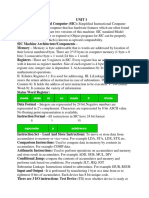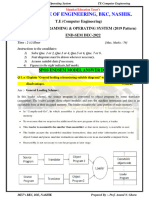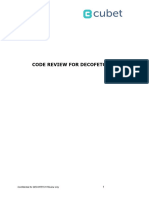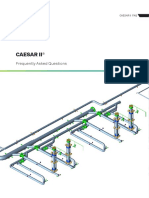Software: Application Software Usually Used by End-User
Software: Application Software Usually Used by End-User
Uploaded by
Arun KumarCopyright:
Available Formats
Software: Application Software Usually Used by End-User
Software: Application Software Usually Used by End-User
Uploaded by
Arun KumarOriginal Title
Copyright
Available Formats
Share this document
Did you find this document useful?
Is this content inappropriate?
Copyright:
Available Formats
Software: Application Software Usually Used by End-User
Software: Application Software Usually Used by End-User
Uploaded by
Arun KumarCopyright:
Available Formats
INTRODUCTION
Software
Application software usually used by end-user It is concerned with the solution of some problem, using the computer as a tool, instead of how computers actually work. System software System software consists of a variety of programs that support the operation of a computer (ex: text editor, compiler, debugger) One characteristic in which most system software differ from application software is machine dependency A system software programmer must know the target machine structure
System Software and Machine Architecture
Machine dependent system software System programs are to support the operation and use of the target computer. The difference between different machine Machine code Instruction formats Addressing mode Registers Machine independent system software General design and logic is basically the same: Code optimization General design and logic of an assembler
System Software
The system software includes Assembler Linker Loader Macro processor Text editor Compiler Operating system Debugging system Source Code Control System (optional) Database Management System
ASSEMBLER
Role of Assembler
Role of Assembler
Source Program
Assembler
Object Code
Linker
Executable Code
Loader
Introduction to Assemblers
Fundamental functions translating mnemonic operation codes to their machine language equivalents assigning machine addresses to symbolic labels Machine dependency different machine instruction formats and codes
Assembler Directives
Pseudo-Instructions Not translated into machine instructions Providing information to the assembler Basic assembler directives START
END BYTE WORD RESB RESW
Assemblers functions
Convert mnemonic operation codes to their machine language equivalents Convert symbolic operands to their equivalent machine addresses Build the machine instructions in the proper format Convert the data constants to internal machine representations Write the object program and the assembly listing
Two Pass Assembler
Pass 1 Assign addresses to all statements in the program Save the values assigned to all labels for use in Pass 2 Perform some processing of assembler directives Pass 2 Assemble instructions Generate data values defined by BYTE, WORD Perform processing of assembler directives not done in Pass 1 Write the object program and the assembly listing
Two Pass Assembler
Read from input line LABEL, OPCODE, OPERAND
Source program
Pass 1
Intermediate file SYMTAB
Pass 2
Object codes
OPTAB
SYMTAB
Data Structures Operation Code Table (OPTAB) Symbol Table (SYMTAB) Location Counter (LOCCTR) OPTAB (operation code table) Content menmonic, machine code (instruction format, length) etc. Characteristic Static table Implementation array or hash table, easy for search. LOCCTR (Location Counter)
It contains the address of the next instruction to be stored in the memory.
SYMTAB None of the relative terms may enter into a multiplication or division operation Errors: BUFEND+BUFFER 100-BUFFER 3*BUFFER The type of an expression Keep track of the types of all symbols defined in the program
Symbol RETADR BUFFER BUFEND MAXLEN
Type R R R A
Value 30 36 1036 1000
MACRO
Introduction Concept A macro instruction is a notational convenience for the programmer It allows the programmer to write shorthand version of a program (module programming) The macro processor replaces each macro invocation with the corresponding sequence of statements (expanding)
Macro Processor
Recognize macro definitions Save the macro definition Recognize macro calls Expand macro calls
Source Code (with macro)
Macro Processor
Expanded Code
Compiler or Assembler
Obj Code
obj
Macro Definition copy code parameter substitution
conditional macro expansion macro instruction defining macros
Copy code -- Example
Source STRG MACRO STA DATA1 STB DATA2 STX DATA3 MEND . STRG . STRG . .
Expanded source . . . STA DATA1 STB DATA2 STX DATA3 . STA DATA1 STB DATA2 STX DATA3 .
LOADERS
Introduction
To execute an object program, we needs Relocation, which modifies the object program so that it can be loaded at an address different from the location originally specified Linking, which combines two or more separate object programs and supplies the information needed to allow references between them Loading and Allocation, which allocates memory location and brings the object program into memory for execution
Type of loaders
Assemble-and-go loader Absolute loader (bootstrap loader) Relocating loader (relative loader) Direct linking loader
Design options
Linkage editors Dynamic linking Bootstrap loaders
Assemble-and-go Loader
Characteristic The object code is stored in memory after assembly Single JUMP instruction Advantage Simple, developing environment Disadvantage Whenever the assembly program is to be executed, it has to be assembled again Programs have to be coded in the same language
Design of an Absolute Loader
Absolute Program Advantage Simple and efficient Disadvantage The need for programmer to specify the actual address Difficult to use subroutine libraries Program Logic Fig. 3.2 Algorithm for an absolute loader
Begin read Header record verify program name and length read first Text record while record type is not E do begin {if object code is in character form, convert into internal representation} move object code to specified location in memory read next object program record end jump to address specified in End record end
Object Code Representation
Figure 3.1 (a) Each byte of assembled code is given using its hexadecimal representation in character form Easy to read by human beings In general Each byte of object code is stored as a single byte Most machine store object programs in a binary form We must be sure that our file and device conventions do not cause some of the program bytes to be interpreted as control characters
A Simple Bootstrap Loader
Bootstrap Loader When a computer is first tuned on or restarted, a special type of absolute loader, called bootstrap loader is executed This bootstrap loads the first program to be run by the computer -- usually an operating system Example (SIC bootstrap loader) The bootstrap itself begins at address 0 It loads the OS starting address 0x80 No header record or control information, the object code is consecutive bytes of memory
Relocating Loaders
Motivation efficient sharing of the machine with larger memory and when several independent programs are to be run together support the use of subroutine libraries efficiently Two methods for specifying relocation Modification record (Fig. 3.4, 3.5) Relocation bit (Fig. 3.6, 3.7)
Each instruction is associated with one relocation bit These relocation bits in a Text record is gathered into bit masks
Modification Record
For complex machines Also called RLD specification Relocation and Linkage Directory
Modification record col 1: M col 2-7: relocation address col 8-9: length (halfbyte) col 10: flag (+/-) col 11-17: segment name
Program Linking
Goal Resolve the problems with EXTREF and EXTDEF from different control sections Linking 1. User, 2. Assembler, 3. Linking loader Example Program in Fig. 3.8 and object code in Fig. 3.9 Use modification records for both relocation and linking Address constant External reference
EDITORS
A text editor is a program that enables you to create and edit text files. The distinction between editors and word processors is not clear-cut, but in general, word processors provide many more formatting features. Interactive program debugging system provides programmers with facilities that aid in the testing and debugging of programs. Although the desirability of such systems has been recognized for some time, there are relatively few actual debugging systems in practical use. The interactive text editor has become an important aspect of almost any computing environment. No longer are editors thought af as tools for programmers. It is now increasingly recognised that text editor should be considered the primary interface to the computer for all types of "knowledge workers" as they compose, organise, study and manipulate computer-based information. An interactive editor is a computer program that allows a user to create and revise a target document. The term document includes objects such as computer programs, text, equation, tables linker, loader and Operating System, diagrams, line art and photographs; anything that one might find on a printed page: A text editor is a program in which the primary elements being edited are character strings of the target text. We also presented a detailed descriptive of Unix operating system. In this unit, we take up issues related to a Text Editor and a Debugging system.
Overview of the Editing Process
The document-editing process is an interactive user-computer dialogue designed to accomplish four tasks: 1) Select the part of the target document to be viewed and manipulated 2) Determine how to format this view on-line and how to display it 3) Specify and execute operations that modify the target document 4) Update the view appropriately. Editing phase involves how the target document is created or altered with a set of operations such as insert, delete, replace, move and copy. The editing functions are often specialised to operate on elements meaningful to the type of editor. For example, a manuscript-oriented editor might operate on elements such as single characters, words, lines, sentences and paragraphs. A program oriented editors might operate on keywords,identifiers and statements.
Types of Editors and User Interface
There are many types of editors, but they fall into two general categories: Line editors: A primitive form of editor that requires you to specify a specific line of text before you can make changes to it. Screen oriented editors: Also called full screen editors, these editors enable you to modify an text that appears on the display screen by moving the cursor to the desired location. The user of an interactive editor is presented with a conceptual model of the editing system. This model is an abstract framework on which the editor and the world on which it operates are based. The conceptual model, in essence provides an easily understood abstractions of the target document and its elements, with a set of guidelines describing the effects of operations on these elements. Besides the conceptual mode, the user interface is concerned with the input devices, the output devices and the interaction language of the system.
You might also like
- Manual GPS Trimble Portugues CFX-750 / FM-750Document246 pagesManual GPS Trimble Portugues CFX-750 / FM-750José Luis Mailkut Pires100% (5)
- System Software NotesDocument100 pagesSystem Software NotesKavin Cavin67% (3)
- What Are System Program?: Explain Drop, Balr, BR, Start, Using, End, DS, DC, EquDocument3 pagesWhat Are System Program?: Explain Drop, Balr, BR, Start, Using, End, DS, DC, EquSomil BichpuriyaNo ratings yet
- Introduction To C Programming: "Turbo C Programming For PC", Robert Lafore, SAMSDocument30 pagesIntroduction To C Programming: "Turbo C Programming For PC", Robert Lafore, SAMSZahid HussainNo ratings yet
- System Software and Operating Systems Unit I Introduction - System Software and Machine Architecture. Loader and Linkers: BasicloaderDocument96 pagesSystem Software and Operating Systems Unit I Introduction - System Software and Machine Architecture. Loader and Linkers: BasicloaderAbhiroopa .SNo ratings yet
- TCS AspireDocument39 pagesTCS AspireSai ChethanNo ratings yet
- Compilati ON: ProcessDocument29 pagesCompilati ON: ProcessSanjeev BhatiaNo ratings yet
- Loaders and Linkers: Basic Loader FunctionsDocument26 pagesLoaders and Linkers: Basic Loader FunctionsAmir RajaNo ratings yet
- 8086 Family Assembly Language Programming - : Lecture Note OnDocument6 pages8086 Family Assembly Language Programming - : Lecture Note Onnskprasad89No ratings yet
- System Software 2 MarksDocument10 pagesSystem Software 2 MarksSharan DeNo ratings yet
- R.V. College of EngineeringDocument34 pagesR.V. College of EngineeringPunith RaajNo ratings yet
- Cousin of CompilerDocument6 pagesCousin of CompilerManinblack ManNo ratings yet
- Unit-1 PCDDocument9 pagesUnit-1 PCDsachinchoudhary1610No ratings yet
- System ProgrammingDocument7 pagesSystem ProgrammingYog KunwarNo ratings yet
- Language Processor NotesDocument4 pagesLanguage Processor NotesfinooshasvNo ratings yet
- UNIT-5 Fundamentals of Information Technology (Question and Answers)Document15 pagesUNIT-5 Fundamentals of Information Technology (Question and Answers)Dr. S.K. SajanNo ratings yet
- 1505901416lect 36 F (1Document6 pages1505901416lect 36 F (1Vishal TalekarNo ratings yet
- 4-The Art of Assembly Language ProgrammingDocument11 pages4-The Art of Assembly Language Programmingafzal_a50% (4)
- System Software Notes 5TH Sem VtuDocument27 pagesSystem Software Notes 5TH Sem VtuNeha Chinni100% (3)
- Assignment No.: 01: Name: Shraddha Umesh Mulay Roll No.: 221083 GR No.: 22020260 Sy-ADocument8 pagesAssignment No.: 01: Name: Shraddha Umesh Mulay Roll No.: 221083 GR No.: 22020260 Sy-Ashraddha mulayNo ratings yet
- Introduction To Assembly Language ProgrammingDocument27 pagesIntroduction To Assembly Language ProgrammingKa Tze TingNo ratings yet
- Familiarization With DSP KitDocument11 pagesFamiliarization With DSP Kitkarthika sudheerNo ratings yet
- Compiler DesignDocument34 pagesCompiler DesignAK CollectionNo ratings yet
- Unit III System SoftwareDocument10 pagesUnit III System SoftwareU Hari KrishnaNo ratings yet
- MIC Chap 2 NotesDocument9 pagesMIC Chap 2 NotesSonali AhireNo ratings yet
- Ch3 Loaders and LinkersDocument18 pagesCh3 Loaders and Linkersabrish.itNo ratings yet
- Compiler Design - Quick GuideDocument38 pagesCompiler Design - Quick GuideThanga DuraiNo ratings yet
- 01 IntroductionDocument26 pages01 IntroductionahmedNo ratings yet
- Introduction To Assembly Language ProgrammingDocument27 pagesIntroduction To Assembly Language ProgrammingKamini SalunkheNo ratings yet
- 15. Compiler DesignDocument18 pages15. Compiler Designkidusyared455No ratings yet
- Module-2: Introduction, Lexical Analysis: SyllabusDocument28 pagesModule-2: Introduction, Lexical Analysis: SyllabusSamba Shiva Reddy.g ShivaNo ratings yet
- COM-212 Introduction To System Programming TheoryDocument44 pagesCOM-212 Introduction To System Programming TheoryOluwafisayo B. AyoadeNo ratings yet
- Compiler DesignDocument11 pagesCompiler DesignHDKHNo ratings yet
- Cousins of CompilerDocument4 pagesCousins of CompilerGokul Raj100% (2)
- Compiler Design - Quick Guide: Language Processing SystemDocument51 pagesCompiler Design - Quick Guide: Language Processing SystemKassieNo ratings yet
- CHAPTER ONE - Introduction To System ProgrammingDocument7 pagesCHAPTER ONE - Introduction To System ProgrammingamanuelNo ratings yet
- IntroductionDocument26 pagesIntroductionHitesh Bhati0% (1)
- Week1 2Document93 pagesWeek1 2İrem Elif KayıplarNo ratings yet
- (Week 1) Lecture 1 & 2: Dr. Naseer Ahmed Sajid Email Id: Whatsapp# 0346-5100010Document7 pages(Week 1) Lecture 1 & 2: Dr. Naseer Ahmed Sajid Email Id: Whatsapp# 0346-5100010Muqaddas ZulfiqarNo ratings yet
- Unit 1. O.SDocument8 pagesUnit 1. O.Spranshukumar9958No ratings yet
- Chapter1 BackgroundDocument20 pagesChapter1 Backgroundraghu dNo ratings yet
- Chapter 7Document8 pagesChapter 7Saud MustafaNo ratings yet
- Notes of System ProgrammingDocument36 pagesNotes of System ProgrammingJaspreet SinghNo ratings yet
- Ss Unit1Document19 pagesSs Unit1msthenmozhiNo ratings yet
- Language Processing System in Compiler Design: Difficulty Level: Last Updated: 22 Feb, 2021Document54 pagesLanguage Processing System in Compiler Design: Difficulty Level: Last Updated: 22 Feb, 2021saniya baigNo ratings yet
- Principles of Compiler Design PDFDocument177 pagesPrinciples of Compiler Design PDFLavlesh Jaiswal0% (1)
- Fundamentals of Computer Unit IIIDocument28 pagesFundamentals of Computer Unit IIIvikas__ccNo ratings yet
- System Software Cs2304 NotesDocument100 pagesSystem Software Cs2304 NotesDinesh GokuladasNo ratings yet
- 2.1 Introduction To Assembly LanguageDocument6 pages2.1 Introduction To Assembly LanguagekveNo ratings yet
- System ProgramingDocument15 pagesSystem ProgramingManish YadavNo ratings yet
- 1. Compiler ConstructionDocument35 pages1. Compiler Constructionabbastayyaba417No ratings yet
- Mpiprogram ManualDocument85 pagesMpiprogram ManualSukumar DasNo ratings yet
- 2a Al Fundamentals New Microproceeor BookDocument50 pages2a Al Fundamentals New Microproceeor BookABDUL HAFEEZNo ratings yet
- System Software 2019Document17 pagesSystem Software 2019SudharshanNo ratings yet
- Spos Endsem Model Answer Jan 2023Document24 pagesSpos Endsem Model Answer Jan 2023ravyarathod344No ratings yet
- Dotnet Framework Q&A SEM VI 2022-2023Document13 pagesDotnet Framework Q&A SEM VI 2022-2023anjali das0% (1)
- Submission Assignment #1: BT602:System ProgrammingDocument6 pagesSubmission Assignment #1: BT602:System ProgrammingSarsij MishraNo ratings yet
- 2 AssemblersDocument12 pages2 AssemblersJagdish BhanushaliNo ratings yet
- The Software Programmer: Basis of common protocols and proceduresFrom EverandThe Software Programmer: Basis of common protocols and proceduresNo ratings yet
- COMPUTER PROGRAMMING FOR KIDS: An Easy Step-by-Step Guide For Young Programmers To Learn Coding Skills (2022 Crash Course for Newbies)From EverandCOMPUTER PROGRAMMING FOR KIDS: An Easy Step-by-Step Guide For Young Programmers To Learn Coding Skills (2022 Crash Course for Newbies)No ratings yet
- Software Suite: Revolutionizing Computer Vision with the Ultimate Software SuiteFrom EverandSoftware Suite: Revolutionizing Computer Vision with the Ultimate Software SuiteNo ratings yet
- Devnet 2893Document40 pagesDevnet 2893LAngel ReyesNo ratings yet
- Discovering AmsterdamDocument632 pagesDiscovering AmsterdamivesomthingtosayNo ratings yet
- 01 Introduction of System ProgrammingDocument12 pages01 Introduction of System ProgrammingSrinu RaoNo ratings yet
- Programming in JavaDocument170 pagesProgramming in JavaRAJESHNo ratings yet
- EULA - MyPhoneExplorerDocument3 pagesEULA - MyPhoneExplorerHeijwNo ratings yet
- Compilers and InterpreterDocument3 pagesCompilers and Interpreterkwekutmen0% (1)
- Misra C 2004Document116 pagesMisra C 2004NeneFINo ratings yet
- Structured Programming Approach NotesDocument278 pagesStructured Programming Approach NotesJohn Downey Jr.100% (2)
- Simics Unleashed - Applications of Virtual Platforms 2013Document197 pagesSimics Unleashed - Applications of Virtual Platforms 2013Wei ZhuangNo ratings yet
- OCR Computer Science A Level: 1.1.1 Structure and Function of The ProcessorDocument471 pagesOCR Computer Science A Level: 1.1.1 Structure and Function of The ProcessorIncognitoNo ratings yet
- MSCAD 2010 Getting Started PDFDocument186 pagesMSCAD 2010 Getting Started PDFMuhammad Salman JavaidNo ratings yet
- Cc101 Introduction To Computing Module 4 5Document10 pagesCc101 Introduction To Computing Module 4 5ʏᴀʜᴀʟʟᴏ •No ratings yet
- Code Review For DecofetchDocument12 pagesCode Review For DecofetchRony JamesNo ratings yet
- English4IT - Unit 2 Introduction To Software ReadingDocument3 pagesEnglish4IT - Unit 2 Introduction To Software Readingpatri_erNo ratings yet
- 8 Lesson System SoftwareDocument8 pages8 Lesson System SoftwareBlack NightNo ratings yet
- SQLsharp ManualDocument218 pagesSQLsharp Manualran_ooNo ratings yet
- Submitted To Bharathiar University in Partial Fulfillment of The Requirements For The Award of The Degree ofDocument63 pagesSubmitted To Bharathiar University in Partial Fulfillment of The Requirements For The Award of The Degree ofGokul KrishnanNo ratings yet
- Bio Statistics - Question & AnswersDocument157 pagesBio Statistics - Question & Answerskhanapurkar82% (11)
- Caesar II FaqsDocument18 pagesCaesar II FaqsVolodymyr Pryz100% (2)
- CARE Analytics - Enhanced Dose Reporting: Dicom Configuration How To Use Dicom InformationDocument27 pagesCARE Analytics - Enhanced Dose Reporting: Dicom Configuration How To Use Dicom InformationbethgocsNo ratings yet
- CM FeatureDescription70Document75 pagesCM FeatureDescription70mivaleria200No ratings yet
- Cambio SoftwareDocument31 pagesCambio SoftwareMario GonzalezNo ratings yet
- The Ins and Outs of SAS® Data Integration StudioDocument16 pagesThe Ins and Outs of SAS® Data Integration StudioLemuel OrtegaNo ratings yet
- Remplazos para IC PhillipsDocument55 pagesRemplazos para IC PhillipsGerardo Contreras SaenzNo ratings yet
- PL 10 CH 1Document31 pagesPL 10 CH 1gobiNo ratings yet
- PML Publisher User Guide 1.1Document19 pagesPML Publisher User Guide 1.1Rancang Persada100% (1)
- Kurikulum Pembanding LNDocument8 pagesKurikulum Pembanding LNHery OktaNo ratings yet
- Assembly Language - WikipediaDocument15 pagesAssembly Language - WikipediaElis Javier Mendez PerezNo ratings yet






